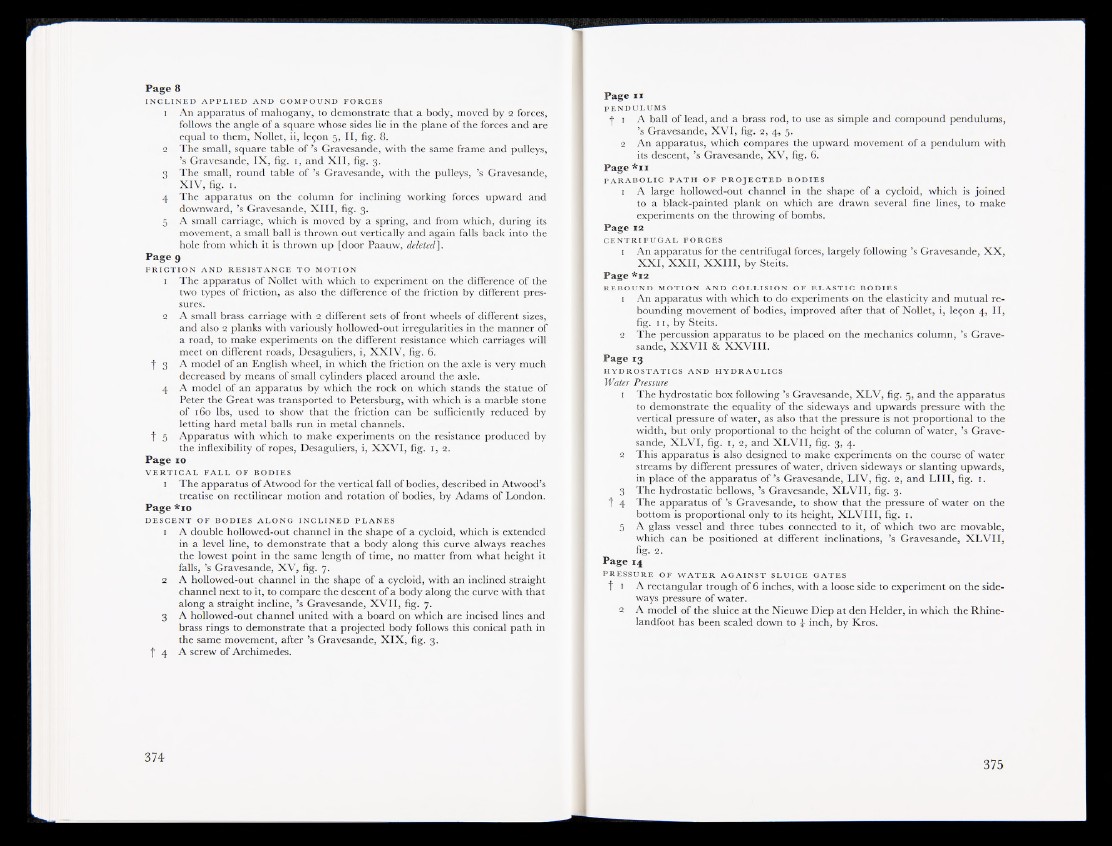
Page 8
IN C L IN E D A P P L IE D AND COMPOUND FORCES
1 An apparatus of mahogany, to demonstrate that a body, moved by 2 forces,
follows the angle of a square whose sides lie in the plane of the forces and are
equal to them, Nollet, ii, legon 5, II, fig. 8.
2 The small, square table o f ’s Gravesande, with the same frame and pulleys,
’s Gravesande, IX, fig. 1, and XII, fig. 3.
3 The small, round table o f ’s Gravesande, with the pulleys, ’s Gravesande,
XIV, fig. 1.
4 The apparatus on the column for inclining working forces upward and
downward, ’s Gravesande, XIII, fig. 3.
5 A small carriage, which is moved by a spring, and from which, during its
movement, a small ball is thrown out vertically and again falls back into the
hole from which it is thrown up [door Paauw, deleted.].
Page 9
F R IC T IO N AND R E S IS TA N C E TO MOTION
1 The apparatus of Nollet with which to experiment on the difference of the
two types of friction, as also the difference of the friction by different pressures.
2 A small brass carriage with 2 different sets of front wheels of different sizes,
and also 2 planks with variously hollowed-out irregularities in the manner of
a road, to make experiments on the different resistance which carriages will
meet on different roads, Desaguliers, i, XXIV, fig. 6.
■f 3 A model of an English wheel, in which the friction on the axle is very much
decreased by means of small cylinders placed around the axle.
4 A model of an apparatus by which the rock on which stands the statue of
Peter the Great was transported to Petersburg, with which is a marble stone
of 160 lbs, used to show that the friction can be sufficiently reduced by
letting hard metal balls run in metal channels.
f 5 Apparatus with which to make experiments on the resistance produced by
the inflexibility of ropes, Desaguliers, i, XXVI, fig. 1, 2.
Page 10
V E R T IC A L F A L L OF BODIES
i The apparatus of Atwood for the vertical fall of bodies, described in Atwood’s
treatise on rectilinear motion and rotation of bodies, by Adams of London.
Page *10
D E S C EN T OF BODIES A LO N G IN C L IN E D PLANE S
1 A double hollowed-out channel in the shape of a cycloid, which is extended
in a level line, to demonstrate that a body along this curve always reaches
the lowest point in the same length of time, no matter from what height it
falls, ’s Gravesande, XV, fig. 7.
2 A hollowed-out channel in the shape of a cycloid, with an inclined straight
channel next to it, to compare the descent of a body along the curve with that
along a straight incline, ’s Gravesande, XVII, fig. 7.
3 A hollowed-out channel united with a board on which are incised lines and
brass rings to demonstrate that a projected body follows this conical path in
the same movement, after’s Gravesande, XIX, fig. 3.
f 4 A screw of Archimedes.
Page 11
PENDULUMS
f i A ball of lead, and a brass rod, to use as simple and compound pendulums,
’s Gravesande, XVI, fig. 2, 4, 5.
2 An apparatus, which compares the upward movement of a pendulum with
its descent, ’s Gravesande, XV, fig. 6.
Page *11
P A R A BO L IC P A TH OF P R O JE C T ED BODIES
i A large hollowed-out channel in the shape of a cycloid, which is joined
to a black-painted plank on which are drawn several fine lines, to make
experiments on the throwing of bombs.
Page 12
C E N T R IFU G A L FORCES
i An apparatus for the centrifugal forces, largely following’s Gravesande, XX,
XXI, XXII, XXIII, by Steits.
Page *12
REBOUND MOTION AND CO L L IS IO N OF E L A S T IC BODIES
1 An apparatus with which to do experiments on the elasticity and mutual rebounding
movement of bodies, improved after that of Nollet, i, legon 4, II,
fig. 11, by Steits.
2 The percussion apparatus to be placed on the mechanics column, ’s Gravesande,
XXVII & XXVIII.
Page 13
H YD RO S TA T IC S AND H YD R A U L IC S
Water Pressure
1 The hydrostatic box following’s Gravesande, XLV, fig. 5, and the apparatus
to demonstrate the equality of the sideways and upwards pressure with the
vertical pressure of water, as also that the pressure is not proportional to the
width, but only proportional to the height of the column of water, ’s Gravesande,
XLVI, fig. 1, 2, and XLVII, fig. 3, 4.
2 This apparatus is also designed to make experiments on the course of water
streams by different pressures of water, driven sideways or slanting upwards,
in place of the apparatus o f ’s Gravesande, LIV, fig. 2, and LIII, fig. 1.
3 The hydrostatic bellows, ’s Gravesande, XLVII, fig. 3.
t 4 The apparatus o f ’s Gravesande, to show that the pressure of water on the
bottom is proportional only to its height, XLVIII, fig. 1.
5 A glass vessel and three tubes connected to it, of which two are movable,
which can be positioned at different inclinations, ’s Gravesande, XLVII,
fig. 2.
Page 14
PRESSURE OF W A T ER A G A IN S T S LU IC E G ATES
f i A rectangular trough of 6 inches, with a loose side to experiment on the sideways
pressure of water.
2 A model of the sluice at the Nieuwe Diep at den Helder, in which the Rhine-
landfoot has been scaled down to \ inch, by Kros.